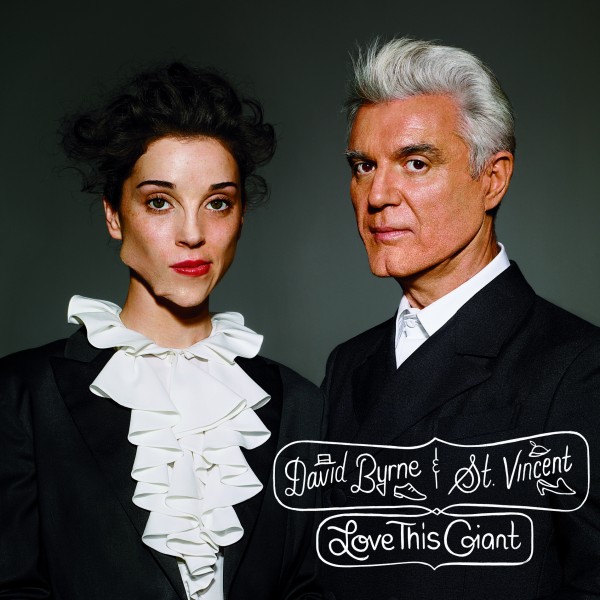 Jonah Bromwich taught Marley Marl how to use the horn stab on Lords of the Underground’s debut.
Jonah Bromwich taught Marley Marl how to use the horn stab on Lords of the Underground’s debut.
David Byrne and Annie Clark of St. Vincent can sometimes come across a little cold. Their music is high fidelity. It’s pointed and perfect. You imagine them leaning over their songs with scalpels, carving out all the excess fat. Doctors Frankenstein, making masterpieces instead of monsters.
They know this. In a recent interview with Pitchfork, Clark said “We both sometimes think of music in terms of riddle and form.” Byrne was even more blunt: “We take an intellectual approach to song construction. The emotion finds its way in there, but it often starts with a somewhat more analytical thing.”
Obviously, this can be problematic. Most people like their music spontaneous, heartfelt, joyous. Though studied calculation can result in great songs, it doesn’t jibe well with the emotional sunbeams and thunderstorms that many music fans expect. If it doesn’t seem that the music-making process was cathartic, then there’s rarely catharsis in the listening.
But Byrne and Clark are too intelligent to be stymied by such silly conundrums. On their new collaborative album Love this Giant, one of their solutions is simple. Brass. Big, farty, sunny brass. Other than the voice (which, duh, shut up), there is no more human-sounding instrument than the horn. In their inability to be whittled down to a narrow strip of sound, in their reverberations, in their overwhelming warmth, brass instruments provide the perfect counterpoint to the egg-headed musical calculus of Byrne and Clark.
One of the best examples of this synthesis comes on the second track, “Weekend in the Dust.” “Once so mysterious,” Clark sings creepily, over a shuffling drumbeat. “Now decoded and human.” It’s pretty, but bloodless — pale as Clark’s skin and if you’ve never seen a picture, she’s pretty pale. After the obligatory sixteen, the horn bumbles in, like the ebullient friend who makes even the most pretentious members of the study group laugh. Rather than clashing with Clark, the music softens her, and makes the affair more pleasant. The horn is the decoder which humanizes the mysterious.
But the horn is multifaceted, and lends more than just warmth to the proceedings. It provides urgency on “I Should Watch TV,” mysticism on “The Forest Awakes” (if you’re into that Decemberists-type medieval sound, which I am decidedly not), and regal vibes on album closer “Outside of Space and Time.” No matter the mood of the song, the brass amplifies and humanizes it.
Of course, Byrne and Clark are fantastic musicians, and they have more going on than a simple brass=humanity equation. The brass is just one of the many ways to key in on Love this Giant, which is really a great album, despite what you may have read. The song “Dinner for Two,” which was knocked by friend of the site/all around gentleman and scholar, Eric Harvey, shows the duo at the absolute height of their powers. The songwriting is spot-on, detailing an odd dinner party where something is not quite right. It all starts normally enough, “table set with china dishes,” guests “welcomed in with tiny kisses.” But there are ominous notes in the music and the lyrics are soon to follow. Harry, an ostensible host is supposed to be getting some appetizers but he’s “keeping out of range of small-arms fire” and Mira “has a phone she says is working/ she’s crawling on the floor across the kitchen.” Things are BAD at this dinner party.
Perhaps the most brilliant thing about this song (needless to say, it’s catchy as hell and pitch-perfect) is the way that it keeps up the conceit of the title. Many songs, many good songs, would execute the “this-dinner-party-is-not-quite-right” trick and call it a day. But Byrne and Clark are a cut above and complete their story.
They establish a relationship between two protagonists in the chorus, as Byrne croons “there’s something I should tell you, but we are never alone.” The protagonists exchange “tender words and sidelong glances” and when they are finally free to leave the house after “maybe a week or so” the narrator asks his companion in Stepford captivity out on a date. Oh and there’s a horn.
I’ve used the following idea before, in a blog about David Bowie, but it applies to Byrne and Clarks’ music (and the music of other technical virtuosos who initially seem to lack soul.See also: James Murphy and Brian Eno). There’s a useful dichotomy between fictional art (which “creates an illusion…as in a figurative painting that asks you to see arrangements of pigment as an apple or a mountain or a saint) and factual art (which “makes an honest transparent statement about itself,…as in an abstract painting whose content is its form: paint on canvas.)
Music like Byrne and Clark’s doesn’t quite work as fictional art—it’s too perfectly calibrated to maintain an illusion, somehow sharper than real life. But as factual art it’s wonderful. And it’s remarkably fun to sit back and remark on how all the little gears (like, for instance, horns) add to the function of such a well-oiled machine.
Download:
Watch:

